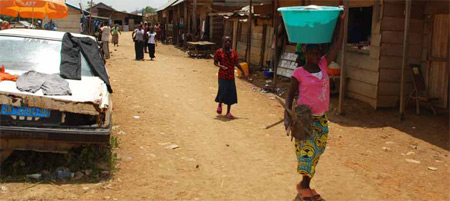
Read our activist brief (PDF) >
Executive summary
The conflict minerals movement is gaining traction. The movement is a pragmatic effort to address one of the principal drivers of atrocities and conflict throughout Congo’s tortured history: the scramble for control of Congo's vast mineral resources. In eastern Congo today, these mineral resources are financing multiple armed groups, many of whom use mass rape as a deliberate strategy to intimidate and control local populations. Armed groups and military units earn hundreds of millions of dollars per year by trading four main minerals: the ores that produce tin, tantalum, tungsten, and gold. This money enables the militias to self-finance their campaign of brutal violence against civilians, with some of the worst abuses occurring in mining areas.
Efforts to end the current violent and corrupt system have gained momentum following passage of ground-breaking U.S. legislation, Section 1502 of the Dodd-Frank Wall Street Reform Act in 2010. Since passage of the legislation, electronics companies, regional governments, and international organizations have accelerated efforts to reform their supply chains, attempting to trace minerals from mine sites to exports, developing audit protocols for smelters, and putting pen to paper on a regional certification plan for the Great Lakes Region of Africa. Although positive steps in the right direction, these many efforts remain rife with loopholes. Those pilot projects that have actually begun implementation remain managed by industry only, with potential for conflicts of interest. There are few to no penalties for noncompliance and there is no independent monitoring system to verify if traders are dealing in conflict minerals. A certification process has been developed by the countries of the International Conference on the Great Lakes Region, or ICGLR, and although promising in design, it remains controlled solely by the governments that have benefited from the trade to date.
Alternatively, a credible certification process led by the United States in partnership with regional governments, governments in consuming countries, business, and local and international civil society, could create a positive alternative to the current system, a responsible means of sourcing Congolese minerals that would create an incentive for Congolese actors to demilitarize the mining sector. But the United States must act quickly, as minerals traders in Congo are already seeking alternative, opaque markets for their minerals. An internationally accepted certification process would deter this development.
In order to inform certification efforts on conflict minerals, this report gleans lessons from other certification processes, including those for fair labor, blood diamonds, forestry, and oil revenue transparency. These processes offer five key lessons that should be incorporated into a certification scheme for conflict minerals:
- A “conductor” is needed to convene a high-level diplomatic partnership on certification and help transform words into action. A “conductor”—a leader with gravitas and political support—is needed to bring stakeholders to the table and to issue a call to action.President Bill Clinton provided a precedent for this when he called together companies and sweatshop labor campaigners in 1996, resulting in the Fair Labor Association certification process.
- Certification should be governed and funded by a multi-stakeholder body that includes companies, governments, and NGOs. The legitimacy of a process rests on a multi-stakeholder governing and funding framework that ensures accountability.
- Certification must include independent third-party auditing and monitoring. Regular independent audits assure the public that the process is credible, and on-the-ground monitoring ensures accuracy.
- Transparency of audits and data is essential to making certification work. Certification processes are moving rapidly towards full disclosure of data and audits.
- Certification must have teeth. Certification can only work if its standards have meaning on the ground and are enforced through penalties for noncompliance.
On conflict minerals, the United States, as home to the largest end-user companies of conflict minerals and as a powerful diplomatic actor in Africa’s Great Lakes region, has a choice: Either exercise leadership and help transform the current process on conflict minerals into real certification or step back and let the vested interests continue to develop systems that lack checks and balances. The administration need not construct an entirely new certification initiative, but it should use its convening power, diplomatic influence, and sanctioning power to strengthen current regional certification plans, harmonize industry efforts and close loopholes.
To this end, the Obama administration should now convene a high-level partnership on certification with leading electronics and end-user companies, together with Congolese President Joseph Kabila and regional governments, aimed at unifying the regional and industry-led initiatives and gaining consensus on a system of independent checks on the ground. The first certification partnership summit should bring together senior executives of end-user companies and political figures and should be followed up every six months to ensure adherence to deadlines and enable support for implementation.
As companies prepare to be compliant with the reporting requirements of the Dodd-Frank legislation, there is increasing anxiety among traders in the Great Lakes region who fear being unable to sell their minerals to international markets. This has created a window for robust reforms. It is critical that certification include independent monitoring, and the administration should as a matter of urgency work to help set up a joint monitoring mechanism to investigate and sanction conflict minerals traders. In addition, the administration should work to ensure a multi-stakeholder governance board, along the lines of other certification processes. It should also urge the Congolese government to prosecute officials and military officers involved in the conflict minerals trade and work with the United Nations to assist with security around mines.

